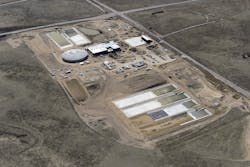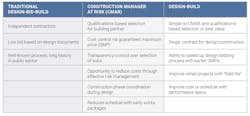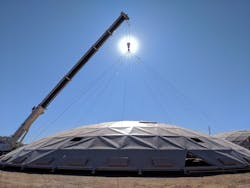Water Infrastructure: The Alternative to Uncertainty
Municipalities across the country are sounding the alarm over increased environmental concerns and funding issues that jeopardize water sustainability, and federal, state and local governments are increasingly focusing their attention on these issues. Solutions that involve expanding, rehabilitating, upgrading or developing new plants and infrastructure while utilizing innovative and sustainable solutions to improve water services are gaining traction.
Traditionally, these large-scale infrastructure projects are constructed using a design-bid-build delivery method. This process has a long history in the public sector and awards the project to the contractor with the lowest bid based on the design documents. Drawbacks of this method include costly change orders, sacrificing quality for sake of budget, and delays to the project resulting from cost overruns or challenges that crop up during construction due to lack of team integration and early planning.
Increasingly, owners are seeking alternative delivery methods for water infrastructure projects due to the benefits they provide related to cost certainty, constructability, schedule reduction and innovation expenditures. And there are financial benefits for municipalities that place a focus on a value-based methodology for water-related capital.
One of the best ways to establish and further deliver value for critical infrastructure construction is via alternative project delivery methods, including construction manager at risk (CMAR) and design-build (DB). Let’s take a closer look at both of these methods.
Construction Manager at Risk or CMAR
This approach is rooted in collaboration and aims to save time, ensure early cost-certainty and maximize efficiency. It features a team-based, concurrent and unified approach to design and construction while maintaining a traditional contracting approach.
A skilled CMAR team will start planning early, ensure all stakeholders are engaged and champion collaborative problem-solving sessions that leave no possibility without analysis and no assumption unquestioned. Owners are an integral part of this team and need to be involved in the planning of the project from the beginning. When a builder can collaborate with owners and designers early on during preconstruction, the best skills of design engineers and builders are brought together with a clear vision from the owner creating a culture of commitment, communication and trust, which results in a project with the highest quality that can be delivered on time and at the best final cost controlled via a guaranteed maximum price (GMP).
CMAR uses a qualifications-based selection process and offers the owner transparency and control over the selection of subcontractors. The process also provides the owner with more certainty and the opportunity to reduce costs through effective risk management, as well as through coordination of the construction phase during design—not after. This allows for innovative problem solving and solutions that bring together construction and design minds for the best possible outcome.
During the $170 million Greenfield Water Reclamation Plant Phase III expansion in Gilbert, Arizona, effective planning and project management with the plant operator and Carollo Engineers throughout the multi-year project resulted in significant cost savings for the city of Mesa, town of Gilbert and town of Queen Creek. The savings were able to be reallocated to an important additional scope of work that was not originally included in Phase III upgrades, namely the removal and replacement of the failed coating systems within the existing digester sludge Ssorage tank and one of the two existing digester vessels. By closely monitoring the risks and cost budgets throughout the project and consistently working to develop cost-cutting measures, the team was able to deliver the savings.
“Early participation by the CMAR was critical in developing an efficient approach to this project. It was not merely constructing a plant, but it was working in a plant that was operating at its full capacity. Every existing process was touched as the new facilities were constructed, tested and brought online. Finding the right sequence kept project resources decisively engaged at each phase of construction. This efficiency, along with early participation in design decisions, was key to generating cost savings,” said Joe Schroeder, city of Mesa project manager. Mesa operates the plant on behalf of the three municipal owners.
“Fully leveraging the advantages that CMAR delivery offers is crucial for complex plant expansion projects with tight budgets like this Phase III Expansion for Greenfield,” said Russ Wachter, P.E., principal in charge for Greenfield WRP design engineer, Carollo Engineers of Phoenix. “Strategies such as bringing in EI&C subcontractors early in a design-assist mode through best-value procurement, and using tools like Design Evolution Logs and design visualization with 3D/BIM modeling allows all stakeholders to make informed decisions at critical junction points. When it comes to value engineering, a true commitment to collaboration and transparency is vital. Value engineering is not just about cost reduction, it requires all team members to keep an open mind about the ‘what’ and ‘how’ project elements can be effectively delivered. While not always easy, it is often necessary.”
Design-Build
This single entity approach capitalizes on common goals to integrate design and construction to maximize intuitive design and the deployment of the newest technologies. There is a single contract for design and construction, and the team is selected via a qualifications-based process or via best value. Additionally, design-build enables the design and bidding process to speed up with earlier work packages.
The current $1.7 billion North East Water Purification Plant project in Humble, Texas, is utilizing a progressive design-build delivery method to construct a 320 mgd surface water treatment facility near Lake Houston. McCarthy’s water team was selected to complete an “early work package” by the Houston Waterworks Team (Jacobs/CDM Smith) and began critical path concrete and underground construction ahead of design completion. This approach jump-started the work-in-place curve, shortening the necessary duration to achieve an early phase water delivery date.
The $125 million Edward W. Bailey Water Treatment Plant in Colorado Springs, Colorado, utilized a design-build delivery method that saved Colorado Springs Utilities $1.6 million through innovative problem-solving by the McCarthy and Carollo design-build team. According to the original geotechnical recommendations, the site required a significant amount of excavation with the need to bring fill in and to compact it. Instead, a solution known as “deep dynamic compaction” was identified where the existing soil was left in place and a crawler crane dropped a large steel tamper in a grid pattern to achieve the same deep compaction that was needed without the costly excavation.
Benefits of Alternative Delivery
Alternative delivery methods like CMAR and design-build provide an owner with the freedom to make changes before they become “change orders,” to consult the contracting community before realizing budgetary shortfalls, and to deliver much needed infrastructure improvements in expedited time frames. As an added bonus, alternative delivery more often capitalizes on sustainability, constructability, operability and other long-term innovative performance criteria as new and alternative methodologies and technologies are identified by stakeholders.
In general, alternative delivery value is most often realized via an increasingly collaborative environment where common goals are expanded and include solutions for risk mitigation, schedule constraints, constructability, quality, safety and overall financial impact. With a massive bipartisan investment by the federal government in infrastructure, including water projects, alternative delivery methods are expected to gain greater traction in the water and wastewater industry over the next several years.
About the authors:
Michaela Rempkowski is Integrated Design Director for McCarthy Building Companies Water Services Group. Rempkowski can be reached at [email protected] Stones is Vice President of Operations with McCarthy Building Companies’ Water Services Group. Stones can be reached at [email protected].
Michaela Rempkowski & Jake Stones



